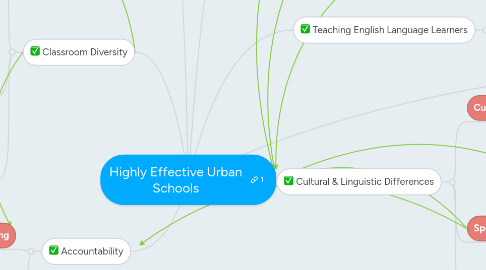
1. Accountability
1.1. High Stakes Testing
1.1.1. For Teachers: High scores result in rewards or recognition Increased motivation to teach the standards Increased opportunities to identify and address students’ areas of need
1.1.2. For School Systems: •Good press, positive school label. • Funds are provided to the “weak” schools in order to increase resources and overall performance • Performance data and efforts are monitored and made accessible to the public • Evaluation and instruction are maintained as reliable and consistent across schools for all students
1.2. ESE & CLD Testing Accountability
1.2.1. http://bilinguistics.com/refer-evaluate-and-treat-diverse-students-confidently/
2. Classroom Diversity
2.1. How Do We See Diversity in Classrooms?
2.1.1. • Cultural Diversity • Linguistic Diversity • Various exceptionalities in general education classrooms • Various socioeconomic factors
2.2. How Can We Meet the Needs of Our Students with Disabilities?
2.2.1. • Incorporate universal design for learning in the classroom o One example would be to create alternative ways for students to both receive and deliver information. • Practice differentiated instruction o Ex. Use a variety of instructional approaches • Implement appropriate accommodations o Ex. Allowing students to use speech-recognition software to complete book reports.
2.3. https://www.youtube.com/watch?v=sgtinODaW78
3. Facilitating Culturally Responsive Practice
3.1. ELL Barriers
3.1.1. • Content • Delivery • Expectations • Assessment • Resources • Outside involvement
3.1.1.1. The six institutional processes include: content, delivery, expectations, assessment, resources, and outside involvement. Although these processes address significant and helpful components which can be accessed and modified to help CLD students strive, if the educator utilizing these processes is not considering the specific needs of the students, they may be hindering the students’ learning and development.
4. Collaborating with Families
4.1. Student Benefits of Partnerships: - More effective individualized programs/plans - Reading & Math Achievement - Positive attitudes toward school - School attendance and retention - Homework completion - Positive behavior in home & school
4.2. Connecting Families with Resources
4.2.1. Informational Support: - Community parent resource centers Economic/Financial Support: - Federal programs (i.e., Supplementary Security Income) - Medicaid programs
4.3. Principles & Partnerships of Trust
4.3.1. Professionals Incorporate the 7 Principles of Partnership with Parents: 1. Communication 2. Professional Competence 3. Respect 4. Commitment 5. Equality 6. Advocacy 7. Trust
4.3.1.1. Trust is KEY
5. Teaching English Language Learners
5.1. Professionals can Differentiate Between Social & Academic Language
5.1.1. Basic Interpersonal Communicative Skills (BICS): - Social Language - Acquired by interacting with peers, family and playmates - Acquired within two years
5.1.2. Cognitive Academic Language Proficiency (CALP): - Academic Language - Acquired within five to seven years - Necessary to achieve academic success
6. Cultural & Linguistic Differences
6.1. Cultural Connections
6.1.1. - Teachers create safe and respectful learning environments - Teachers incorporate empathetic listen when students communicate and do not react negatively to their style of communication. - Teachers listen to what students have to stay instead of how they say it. - Teachers motivate all students to participate in class instruction, activities, and in discussions.
6.2. Special Education Culture
6.2.1. • Part of the larger culture of US education • Aligned to American core values o Protection of our individual rights Freedom of speech Individualism Equality Achievement by hard work Social mobility
6.3. Cultural Responsiveness
6.3.1. https://www.youtube.com/watch?v=uV36efjBKRU
